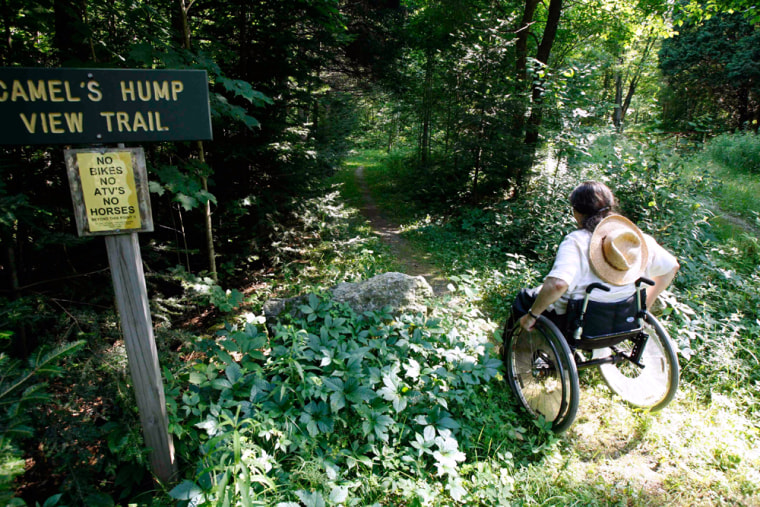Like many Vermonters, Deborah Lisi-Baker enjoys the outdoors. "I've always loved the wilderness and the woods. It's very serene. It clears your head just to get to appreciate all the sounds and colors and shapes."
Lisi-Baker, 55, uses a wheelchair, meaning that the trails that lace up and down Vermont's Green Mountains are largely inaccessible to her.
But that may be changing, at least in a small way. A new trail that opened earlier this summer here is the state's third wheelchair-accessible trail, and similar efforts are underway elsewhere — including a new online resource that's being created by the National Park Service to list trails, activities and other experiences that are accessible.
The National Park Service program will be launched in September, according to Gerry Gaumer, spokesman for the agency. The objective, he said, "is to put all the information on one Web site, where people can access not only trails but also other programs that are accessible," such as museum exhibits, camp sites and visitors centers. Gaumer said most national parks have some accessible facilities, but the information has never been compiled in one place before. (The Web link for the program will be made public in September.)
In Vermont, the Baldwin Trail on Mount Independence was dedicated July 1, opening for the public parts of an important Revolutionary War historic site, including archaeological sites and vistas of the Lake Champlain Valley, for the first time. The 1.6-mile trail has gentle grades and packed surfaces, making it accessible for wheelchairs.
In Killington, the Green Mountain Club has been working this summer to finish a project relocating part of the Appalachian Trail to get it away from roads. The project has grown to include a new wheelchair-accessible boardwalk. When it opens this fall, it will be the first section of the Appalachian Trail in northern New England to be designed as wheelchair-accessible. Nearly 1,000 feet long, it passes a spectacular view of the Thundering Brook falls and through the Ottauquechee River flood plain.
The Camel's Hump View Trail was built in the early 1990s, shortly after passage of the Americans with Disabilities Act, the federal law designed to reduce or eliminate barriers to people with disabilities. The gently sloped loop trail, not quite a mile long, provides close-up views of Camel's Hump, Vermont's most iconic mountain. The trail was built with tightly packed gravel, which holds up well under a wheelchair. And it's part of a nationwide push in the past 20 years to make more of the great outdoors accessible to people with disabilities.
"This is just gorgeous," Lisi-Baker said on her first trip to Camel's Hump View earlier this summer. She was born with cerebral palsy and now works as executive director of the Vermont Center for Independent Living.
Gaumer said park officials and the public are "all becoming more and more aware of the need to make the parks accessible. The handicapped population is saying, 'Hey, work with us, we have the right to visit the area, too.' You shouldn't have to rely on a law to make you do something."
